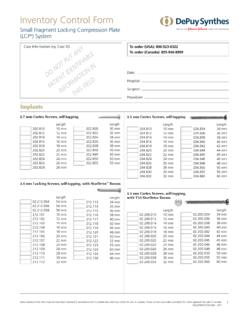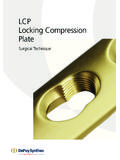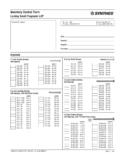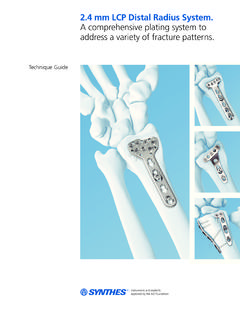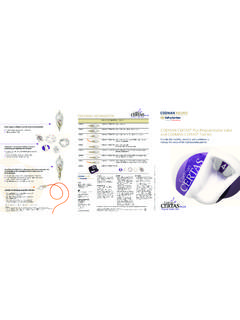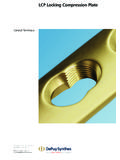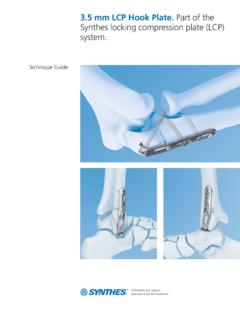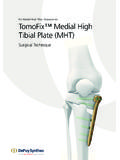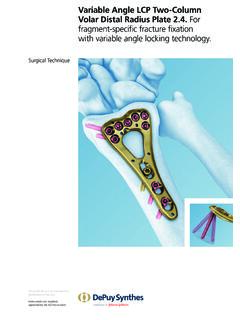Transcription of VA-LCP Olecranon Plates 2.7/3.5. The fracture-specific low ...
1 VA-LCP Olecranon Plates The fracture - specific low-profile fixation system with variable angle locking technology. Surgical Technique This publication is not intended for distribution in the USA. Instruments and implants approved by the AO Foundation. Image intensi er control This description alone does not provide sufficient background for direct use of DePuy Synthes products. Instruction by a surgeon experienced in handling these products is highly recommended. Processing, Reprocessing, Care and Maintenance For general guidelines, function control and dismantling of m ulti-part instruments, as well as processing guidelines for i mplants, please contact your local sales representative or refer to: For general information about reprocessing, care and maintenance of Synthes reusable devices, instrument trays and cases, as well as processing of Synthes non-sterile implants, please consult the Important Information leaflet (SE_023827) or refer to: Table of Contents Introduction VA-LCP Olecranon Plates 2.
2 AO Principles 4. Indications 5. Surgical Technique Preparation and Approach 6. Determination of fixation Technique 10. Insert Plate 12. Insert Proximal Screws 16. Insert Plate-Shaft Screws 21. Implant Removal 25. Product Information Implants 26. Instruments 28. Bibliography 32. MRI Information 33.. VA-LCP Olecranon Plates Surgical Technique DePuy Synthes 1. VA-LCP Olecranon Plates The fracture - specific low-profile fixation system with variable angle locking technology. fracture - specific proximal ulna Plates enable the surgeon to address the specific biomechanical requirements of each fracture pattern.
3 Proximal Olecranon Plate Olecranon Plate 2. 1. 2. 1. 3. 1 Long proximal extension and multiple screw options to 1 Proximal extension with multiple screw options secures secure small Olecranon fragments to help neutralize the the Olecranon and helps to neutralize the forces of the forces of the triceps muscle. triceps muscle. 2 Notches to help minimize interference with the triceps 2 Various screws target to help stabilize the coronoid, tendon. thereby helping to restore bony and ligamentous struc- 3 Tapered shaft thickness minimizes plate prominence. tures, which are important for elbow-joint stability.
4 2 DePuy Synthes VA-LCP Olecranon Plates Surgical Technique Proximal Ulna Plate, extra-articular variable angle locking variable angle locking screws mm give the surgeon the ability to create a fixed-angle construct with the freedom of up to 15 off-axis screw angulation. 2. 1. 1 Reinforced shaft neutralizes diaphyseal bending forces. 2 Minimized proximal extension avoids interference with the triceps tendon. VA-LCP Olecranon Plates Surgical Technique DePuy Synthes 3. AO Principles In 1958, the AO formulated four basic principles, which have become the guidelines for internal fixation1, 2.
5 1 12:08. Anatomic reduction Stable fixation fracture reduction and fixation to fracture fixation providing absolute or restore anatomical relationships. relative stability, as required by the 1 2 patient, the injury, and the personality of the fracture . Early, active mobilization Early and safe mobilization and 4 3 Preservation of blood supply Preservation of the blood supply to soft rehabilitation of the injured part and tissues and bone by gentle reduction the patient as a whole. techniques and careful handling. Copyright 2007 by AO Foundation 1. M ller ME, M Allg wer, R Schneider, H Willenegger.
6 Manual of Internal fixation . 3rd ed. Berlin Heidelberg New York: Springer. 1991. 2. R edi TP, RE Buckley, CG Moran. AO Principles of fracture Management. 2nd ed. Stuttgart, New York: Thieme. 2007. 4 DePuy Synthes VA-LCP Olecranon Plates Surgical Technique Indications VA-LCP Proximal Olecranon Plates Fractures of the proximal Olecranon Osteotomies of the Olecranon for distal humerus fracture treatment VA-LCP Olecranon Plates Intra-articular fractures of the Olecranon including fractures extending into the coronoid Nonunions of the Olecranon Osteotomies of the Olecranon ( due to malunions, deformities).
7 VA-LCP Proximal Ulna Plate, extra-articular Extra-articular fractures of the proximal ulna Nonunions of the proximal ulna Osteotomies of the proximal ulna ( due to malunions, deformities). VA-LCP Olecranon Plates Surgical Technique DePuy Synthes 5. Preparation and Approach Note: For information on fixation principles using conven . tional and locked plating techniques, please refer to the LCP Locking Compression Plate Surgical Technique (DSEM/TRM/0115/0278). 1. Preoperative planning Complete the preoperative radiographic assessment and prepare the preoperative plan. Use the x-ray templates for the VA-LCP Olecranon Plates ( ) to determine the plate type, length, and the position of the screws.
8 6 DePuy Synthes VA-LCP Olecranon Plates Surgical Technique 2. Position patient Position the patient in supine, prone or in lateral decubitus with the arm on a radiolucent support, or a padded post. The forearm should be positioned such that it can be flexed to an angle greater than 120 degrees. VA-LCP Olecranon Plates Surgical Technique DePuy Synthes 7. Preparation and Approach 3. Approach Make an incision running posteriorly from the supracondylar area to a point 4 5 cm distal to the fracture . The incision may curve slightly to the radial side to protect the ulnar nerve. The type of approach is determined by the character of the fracture , and the preference and experience of the surgeon.
9 8 DePuy Synthes VA-LCP Olecranon Plates Surgical Technique 4. Reduce fracture and provide temporary fixation Instrument Reduction Forceps with Points, asymmetric, with Speed Lock, length 195 mm Reduce the fracture directly or indirectly depending on the fracture type. Ensure that the coronoid is properly reduced prior to fixation . Use forceps and Kirschner wires for temporary fixation . Ensure that the reduction forceps or Kirschner wires will not interfere with subsequent plate placement. Reduction with asymmetric reduction forceps Note: Always use two asymmetric reduction forceps; one on each side of the ulna.
10 Drill two short holes in the ulnar shaft distal to the fracture line and insert the straight portion of the forceps into the hole. Secure the proximal fragment with the curved portion and compress carefully. VA-LCP Olecranon Plates Surgical Technique DePuy Synthes 9. Determination of fixation Technique Select a plate type and length appropriate for the fracture . Choose plate lengths that offer sufficient fixation distal to the fracture line. 1. Determine plate type and length Instruments Trial Implants for VA-LCP Proximal Olecranon Plate, Olecranon Plate or Proximal Ulna Plate , right or left Note: Do not bend trial implants.
